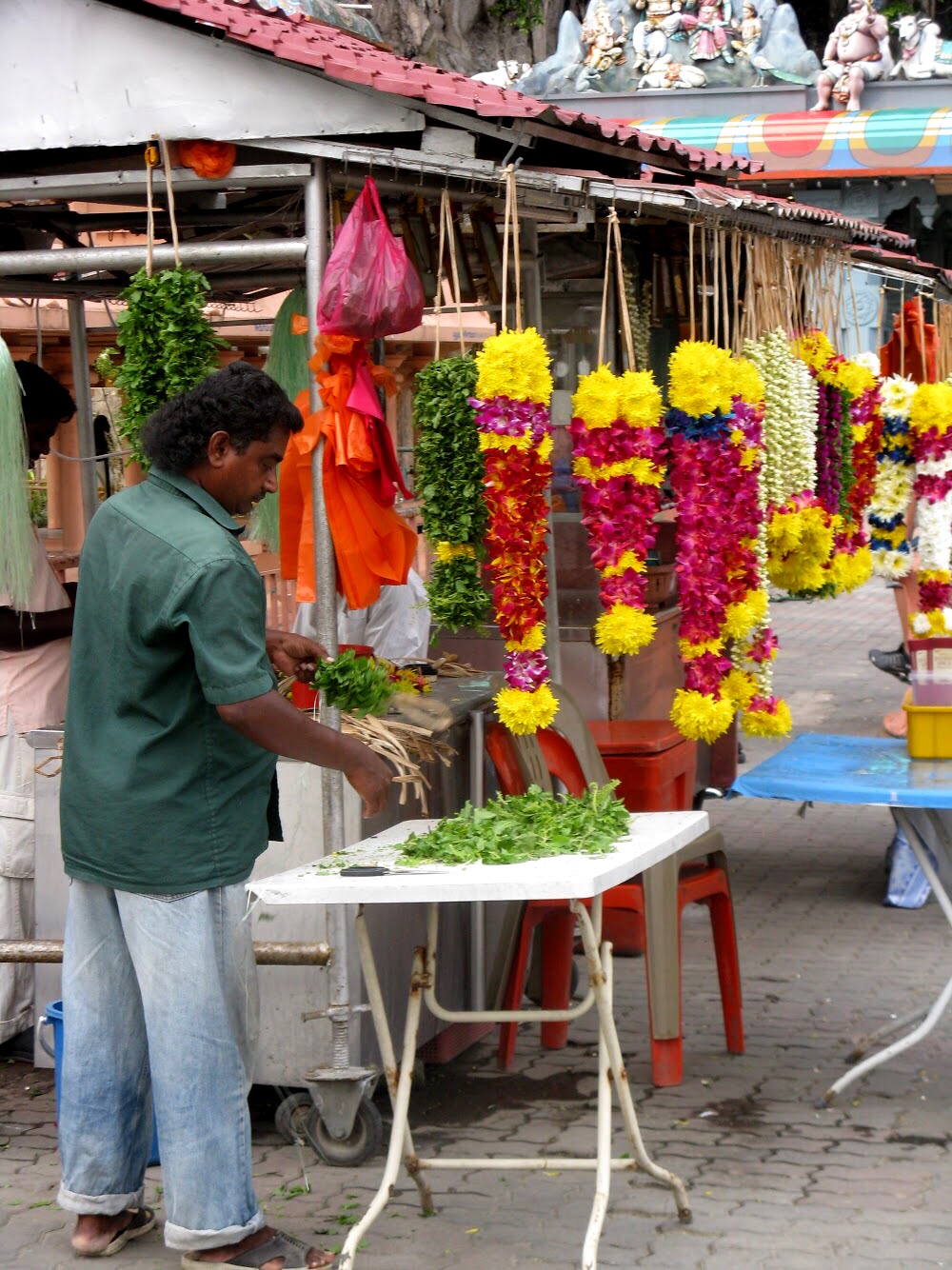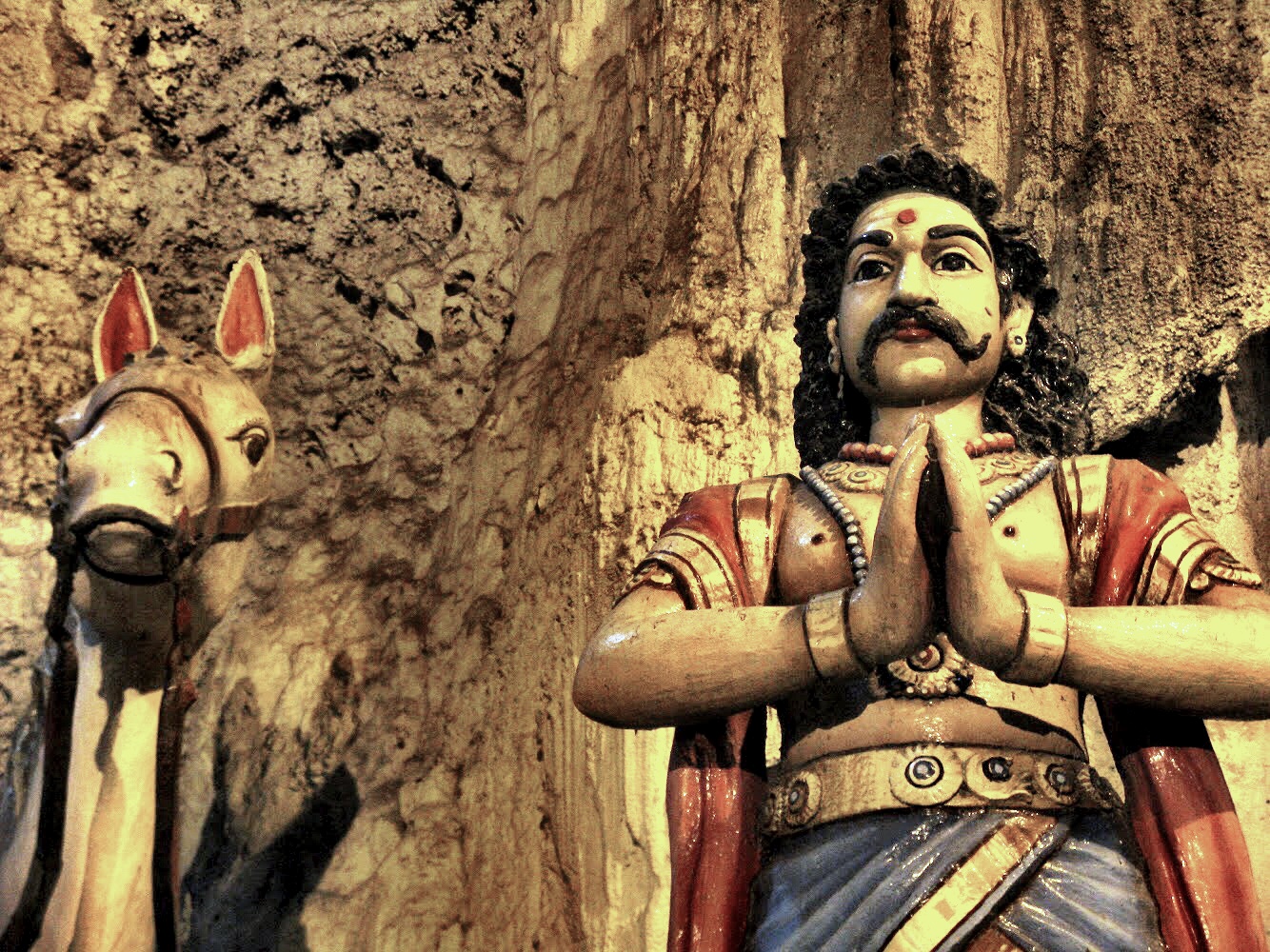Brave the steps, stench and wild macaques at one of the most interesting Kuala Lumpur attractions.
The Batu Caves is a major pilgrimage site just to the north of Kuala Lumpur
The first thing you notice when you visit the Batu Caves — aside from the giant gold statue and all the monkeys — is the smell. It’s a pungent mixture of body odor, guano and garbage, all stewing in the oppressive Malaysian heat.
Hindu shrines are built into the limestone cliffs
What are the Batu Caves?
This site, nine and a half miles north of Kuala Lumpur (often shortened to KL), has been a place of worship for Hindus for over a century. The limestone hills are 400 million or so years old and were once shelters for the indigenous Temuan people.
The Batu Caves are described as the most holy Hindu temple outside of India.
“During the Thaipusam Festival, hooks and skewers pierce the skin, cheeks and tongues of penitents. Eww.”
A depiction of Kamadhenu, the Mother of All Cows
Hindu statues tend to be awash in bright colors
The iconography around the site can be a bit of a shock — especially if you've never visited a Hindu shrine before. Churches tend to be less flamboyant, even those awash in a gilded glory. And mosques are often understated, austere, devoid of excess ornamentation, in part because of the absence of statues — Muslims believe it’s sacrilege to portray their holy personages.
Not so Hindus. In fact, you'll find numerous statues of their deities and the animals associated with them throughout the Batu Caves. They're painted in bright rainbow colors. This was the first time I had seen this style of Hindu statuary. It surprised me how cartoonish the bizarre figures were. It struck me as more of something to decorate a theme park than a temple.
At the base of the stairs, vendors sells floral offerings to the gods
Food and flower vendors peddle their wares at the base of a dauntingly long set of stairs.
To reach the main cave, you have to climb a lot of steps — 272, to be exact
Duke and Fatima found that going down was a lot easier than going up
Maybe the smell got to be too much for Vanessa, though our hostess Angie, who lived in KL, seems used to it
How many steps are there?
272. In fact, they’re numbered for your convenience, though I’m not sure that’s a good thing.
Everything in the caves is cast in an eerie yellow glow
What’s inside the caves?
The reward at the top of the stairs is Cathedral Cave, the main cavern. You’ll find various shrines to Hindu deities scattered throughout the interior. There’s nothing impressive about the shrines; they’re quite small and, if I’m being honest, sad-looking.
In one nook of Cathedral Cave, a man wore a snake
A lizard lounging in the caves
Small groups of worshippers sit in rows in front of the shrines, and when we visited, there was a man with a snake around his neck and a large lizard perched on a stick.
The artificial lighting casts an eerie, jaundiced glow to everything.
We only explored the main cavern, though there are other caves at the foot of Batu Hill: Art Gallery Cave and Museum Cave, which feature Hindu statues and paintings. The Ramayana Cave is a newer addition and is said to have psychedelic paintings and a 50-foot statue of the monkey god Hanuman (appropriate for a site teeming with his brethren).
The Batu Caves are popular with Hindu worshippers, especially during the Thaipusam Festival, when hundreds of thousands of pilgrims descend upon the temple
Who visits the Batu Caves?
The caves are one of the most popular tourist attractions in the Kuala Lumpur area. It’s also a major pilgrimage site for Hindus during the festival of Thaipusam. The number of devotees who descend upon the Batu Caves is said to reach 1 million. I can’t even imagine how crowded and claustrophobic that would be — not to mention the gag-worthy stench.
Cows are revered in Hinduism
What’s the Thaipusam Festival?
It’s held at the end of January or beginning of February, with a procession that starts in the evening at the Sri Mariamman Temple in KL. Worshippers arrive at the Batu Caves in the wee hours of the morning.
It’s not unusual for Hindu deities to have multiple faces and arms
To make the festival even more intense, the devotees carry large wood or steel frames called kavadis (literally, “burdens”) on their shoulders. They’re brightly colored, decorated with flowers and feathers and can weigh over 200 pounds. The kavadis carry offerings of containers of milk to Lord Muruga. Hooks and skewers attached to the kavadis pierce the skin, cheeks and tongues of those carrying them. Eww.
The gold statue of Lord Murugan rises 140 feet into the air
Who’s the huge statue of?
That’s Lord Murugan, the milk-loving young god of war in Hinduism. He’s the son of Shiva and Parvati, who meditated until a giant fireball formed that eventually became a baby with six faces. Primarily worshipped in Southern India, Murugan led an army of devas, or divine beings, in a successful battle against demons.
The statue stands 140 feet tall, its framework of steel bars and concrete covered by 300 liters of gold paint from Thailand that can be blinding in the sunlight.
Wild macaque monkeys roam the grounds of the Batu Caves
What about those monkeys?
There are long-tailed macaques everywhere at the Batu Caves. They’re mangy-looking and can be quite aggressive in their scrounging for food. I don’t recommend getting too close to them — which is why I was somewhat horrified that Duke decided this was when he’d get over his fear of monkeys.
The monkeys at the caves rummage for food — be careful!
The macaques clamber about the stair railings and pick through the garbage that’s scattered throughout the complex.
Standing at the top of the steps on a hazy day, looking toward KL
How can I get there?
The KTM Komuter Train from KL Sentral downtown will take you right to the Batu Caves. –Wally
Batu Caves
Gombak
68100 Batu Caves
Selangor, Malaysia






































